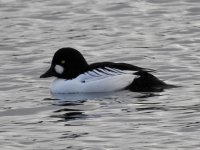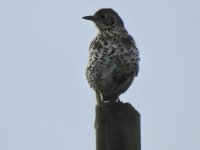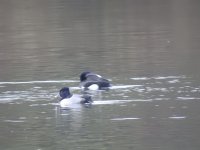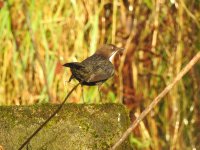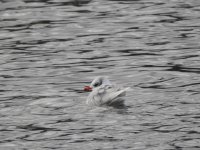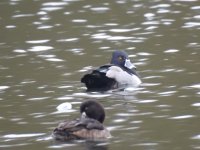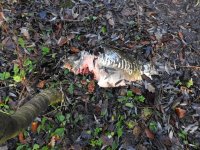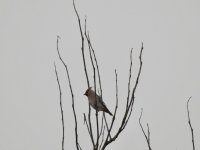I'll be back to give it another go. The Godwit flock never really got that close to the centre, other than when I went for a wander around past the gas works. That was the one occasion an aircraft from the base came over and spooked them. I got back to the centre, and a Buzzard went over and spooked them again, so they headed back towards the gas works. I'd hoped the tide would push them back towards the centre, but the flock headed for Balgove.I saw the godwit on Monday (and it was seen today). Until you get your eye in, it is quite subtle to pick out on the ground (much easier when it takes off). I think you will have plenty of opportunities to see it. It seems to have settled down to hanging out with the blackwits in the last week or two, and spending less time on its own.
Good luck!
Rob
-
Welcome to BirdForum, the internet's largest birding community with thousands of members from all over the world. The forums are dedicated to wild birds, birding, binoculars and equipment and all that goes with it.
Please register for an account to take part in the discussions in the forum, post your pictures in the gallery and more.
You are using an out of date browser. It may not display this or other websites correctly.
You should upgrade or use an alternative browser.
You should upgrade or use an alternative browser.
Seafield to Kinghorn (4 Viewers)
- Thread starter Gander
- Start date
More options
Who Replied?Cuckoo-shrike
Well-known member
Hi Paul
Sorry not to have got back to you sooner. I've been waiting on the Birdtrack records for the Loch which have now been kindly supplied via the Fife Bird Club. If you PM me your email address I'll send them through, although it's just a species list without details of sightings and I don't think there's anything there that you haven't already seen. Dipper is the best and you've recorded that there, as has the Ecology Centre's Site Manager, who incidentally told me this week there are two Kingfishers currently visiting.
I found out that Danny Wallace has moved away to Lochearnhead and I don't have contact details for him.
Cheers
Andy
Sorry not to have got back to you sooner. I've been waiting on the Birdtrack records for the Loch which have now been kindly supplied via the Fife Bird Club. If you PM me your email address I'll send them through, although it's just a species list without details of sightings and I don't think there's anything there that you haven't already seen. Dipper is the best and you've recorded that there, as has the Ecology Centre's Site Manager, who incidentally told me this week there are two Kingfishers currently visiting.
I found out that Danny Wallace has moved away to Lochearnhead and I don't have contact details for him.
Cheers
Andy
Hi Andy,Hi Paul
Sorry not to have got back to you sooner. I've been waiting on the Birdtrack records for the Loch which have now been kindly supplied via the Fife Bird Club. If you PM me your email address I'll send them through, although it's just a species list without details of sightings and I don't think there's anything there that you haven't already seen. Dipper is the best and you've recorded that there, as has the Ecology Centre's Site Manager, who incidentally told me this week there are two Kingfishers currently visiting.
I found out that Danny Wallace has moved away to Lochearnhead and I don't have contact details for him.
Cheers
Andy
I have sent you my e-mail address.
The list will be useful, as I've started collating reports off Birdtrack. I have a list of 58 species, outside of what I've seen, that I need to check against Birdtrack. Most of those species would not be hugely surprising, so it is going to be interesting to see what we end up with. It is a pity that Danny W is not about, however, although his entries to Birdtrack were named as anonymous, his title for the patch is unique, and I've identified his reports using the birds from the article and the unique location title.
Once I receive your list, I'll double check it against Birdtrack to try and get some dates, and maybe observer names. That should give us an idea of if some species are regular visitors or just the odd sighting.
All birding had been suspended for a day and a half due to heavy rain, but I managed to return to the loch at midday. I found the whole area was leaking; with water flowing out of every edifice on the hillside. The marsh area was no longer a marsh; but a full on pond. In short it was wet! With limited time, I decided to dispatch with the formality of making a list, but would simply note anything different from Thursday's visit.
The first thing noted was a Reed Bunting at the parking area. Not seen on my last visit.
The next thing noted was that although the Goldeneye count was about the same as previous, there were now more males than females. a total opposite from Thursday. Also noted was the increase in Tufted Duck. Thirty-eight were counted, so more than double the number on my last list. And amongst them was the resident Pochard that I had not located last time.
I took a different route up the wooded hillside, hoping for Woodcock, but none seen. Heading along the old cart road, there were Fieldfare and Redwing evident, but they were not as active as previously witnessed. Two distant Buzzards were seen; again a species absent on my last outing. The hill I was passing by, is, I recently learned, called Cow Hill. I can't help but smile each time I think of that, remembering the great poet's words...
I saw a coo on yonder hill
It's not there noo
I think it's ill.
Anyway, enough of Spike Milligan, and back to the birds. Reaching the farmhouses, I turned up the track to the cottages. Just past these buildings, I noticed a small group of thrush. Fieldfare and Redwing were on the grass of one of the sheep paddocks. As a watched though, a Mistle Thrush flew in and dispersed the gathering with a rattling call. Another new bird for the week though.
I carried on past the covered reservoirs and the big cereal field before joining the Kissing Trees Lane and decending down to the car park. On my way, I spotted several Linnet, also new to this week's observations. At the feeders near the Ecology Centre, a Tree Sparrow was seen. First for the loch this week, but already on the list due to a few being seen at Seafield.
Finally, at the car park, a Wren popped up. Strangely absent from the loch on Thursday.
Apologies for the dodgy record shots. Light was awful!
The first thing noted was a Reed Bunting at the parking area. Not seen on my last visit.
The next thing noted was that although the Goldeneye count was about the same as previous, there were now more males than females. a total opposite from Thursday. Also noted was the increase in Tufted Duck. Thirty-eight were counted, so more than double the number on my last list. And amongst them was the resident Pochard that I had not located last time.
I took a different route up the wooded hillside, hoping for Woodcock, but none seen. Heading along the old cart road, there were Fieldfare and Redwing evident, but they were not as active as previously witnessed. Two distant Buzzards were seen; again a species absent on my last outing. The hill I was passing by, is, I recently learned, called Cow Hill. I can't help but smile each time I think of that, remembering the great poet's words...
I saw a coo on yonder hill
It's not there noo
I think it's ill.
Anyway, enough of Spike Milligan, and back to the birds. Reaching the farmhouses, I turned up the track to the cottages. Just past these buildings, I noticed a small group of thrush. Fieldfare and Redwing were on the grass of one of the sheep paddocks. As a watched though, a Mistle Thrush flew in and dispersed the gathering with a rattling call. Another new bird for the week though.
I carried on past the covered reservoirs and the big cereal field before joining the Kissing Trees Lane and decending down to the car park. On my way, I spotted several Linnet, also new to this week's observations. At the feeders near the Ecology Centre, a Tree Sparrow was seen. First for the loch this week, but already on the list due to a few being seen at Seafield.
Finally, at the car park, a Wren popped up. Strangely absent from the loch on Thursday.
Apologies for the dodgy record shots. Light was awful!
Attachments
I received an exciting e-mail from Cuckoo-shrike (Andy) yesterday, announcing the presence at the loch of a special visitor. The visitor in question was a Ring-Necked Duck. I then spent the rest of the evening kicking myself, because it was after dark before I'd got around to checking my e-mails. Following a quick negotiation with swmbo, I rearranged my plans for the next day and went to bed like a child before Christmas. Indeed, I could not stay in bed beyond 4:30 am, so I spent several hours willing the dawn's light to spread across the sky.
As soon as the light was approaching half decent, I was out the door, and soon rolling up along side the loch. It was very quiet! From the car park, I could see a small group of Tufted Duck at the very far end of the loch. Certainly not the 38 I had counted a couple of days past. I feared that my target may have moved on with a large chunk of the recent Tufty population.
I hurried along the loch side path, and as I approached the top end, I stopped and set up my scope. The group of Tufted was small. Less than a dozen. I scanned them quickly, and noticed nothing out of the ordinary. My thoughts were that this was going to be a most painful dip on home soil. Then, I noticed duck that didn't look right for a Tufted. It was bobbing about on the edge of the group, with its head under a wing, but from the grey in the flank, I knew I had my bird. A few minutes later, it popped its head out from under the wing, and confirmed that it was indeed a Ring-Necked Duck.
I tried for an hour to get a decent photo, but the poor light prevented that, so eventually, I headed back to the car to dump the scope before heading up the hill. On my way to the car, I took time to scan the gull flock that had swollen in numbers to about one thousand. Mediterranean Gulls had also been reported by Andy as being present on the previous day, but I found none. I did however spot a Great Black-Backed Gull in the throng. A personal loch tick for me!
On my way back from the car, there was movement that caught my eye as I again passed the mill stream. A Dipper was again present, in exactly the same place as seen back in October.
The woodland and hilltop pastures were fairly quiet, and I struggled to find much in the way of finches or tits until I reached the cottages. Looping around the big cereal field, I descended the Red Path Byres trail back down to the loch. With the time now at about midday, I'd hoped that with the sun now shining through on occasion, that I might get a better shot of the R-N Duck. Sadly, there was no sign of the Tufted Ducks, let alone the R-N Duck. Earlier, when I passed along the old cart road up on the hill, I remembered that there had been a commotion with the ducks at the top end of the loch. Certainly a lot of the Mallards took to the air, as I saw them flying along the water. I suspect that the Tufted, plus one, also lifted at that time.
With no R-N D to photograph, I decided to give the gull flock, that had now shrunk considerably, a last scan. It proved worthwhile because in addition to a distant over-wintering Lesser Black-Backed Gull, I found my first loch Med Gull. Another personal loch tick! I also ran into another birder, who pointed out that there were actually two Med Gulls in the flock. This birder turned out to be Cuckoo-shrike (Andy), so we are now able to put faces to the names.
132 (63) - Ring-Necked Duck
64 - Great Black-Backed Gull
65 - Mediterranean Gull
As soon as the light was approaching half decent, I was out the door, and soon rolling up along side the loch. It was very quiet! From the car park, I could see a small group of Tufted Duck at the very far end of the loch. Certainly not the 38 I had counted a couple of days past. I feared that my target may have moved on with a large chunk of the recent Tufty population.
I hurried along the loch side path, and as I approached the top end, I stopped and set up my scope. The group of Tufted was small. Less than a dozen. I scanned them quickly, and noticed nothing out of the ordinary. My thoughts were that this was going to be a most painful dip on home soil. Then, I noticed duck that didn't look right for a Tufted. It was bobbing about on the edge of the group, with its head under a wing, but from the grey in the flank, I knew I had my bird. A few minutes later, it popped its head out from under the wing, and confirmed that it was indeed a Ring-Necked Duck.
I tried for an hour to get a decent photo, but the poor light prevented that, so eventually, I headed back to the car to dump the scope before heading up the hill. On my way to the car, I took time to scan the gull flock that had swollen in numbers to about one thousand. Mediterranean Gulls had also been reported by Andy as being present on the previous day, but I found none. I did however spot a Great Black-Backed Gull in the throng. A personal loch tick for me!
On my way back from the car, there was movement that caught my eye as I again passed the mill stream. A Dipper was again present, in exactly the same place as seen back in October.
The woodland and hilltop pastures were fairly quiet, and I struggled to find much in the way of finches or tits until I reached the cottages. Looping around the big cereal field, I descended the Red Path Byres trail back down to the loch. With the time now at about midday, I'd hoped that with the sun now shining through on occasion, that I might get a better shot of the R-N Duck. Sadly, there was no sign of the Tufted Ducks, let alone the R-N Duck. Earlier, when I passed along the old cart road up on the hill, I remembered that there had been a commotion with the ducks at the top end of the loch. Certainly a lot of the Mallards took to the air, as I saw them flying along the water. I suspect that the Tufted, plus one, also lifted at that time.
With no R-N D to photograph, I decided to give the gull flock, that had now shrunk considerably, a last scan. It proved worthwhile because in addition to a distant over-wintering Lesser Black-Backed Gull, I found my first loch Med Gull. Another personal loch tick! I also ran into another birder, who pointed out that there were actually two Med Gulls in the flock. This birder turned out to be Cuckoo-shrike (Andy), so we are now able to put faces to the names.
132 (63) - Ring-Necked Duck
64 - Great Black-Backed Gull
65 - Mediterranean Gull
Attachments
I headed for the Seafield strip yesterday afternoon, despite the gloomy skies that threatened rain. In fact for most of my walk along the strip, it was intermittently spitting, so once again, I did not go beyond the stone dyke. There was not much about1 The tide was halfway out, which is never great for locating shoreline species, and as at the beginning of the week, I could not find either a Rock Pipit or a Purple Sandpiper. My resident Stonechats were also once again conspicuous by their absence. The only addition to the week's species count for the patch was a Pied Wagtail
Once home again, I decided to return the next day (today), shortly after dawn, at high tide. The decision proved worthwhile, as despite the again rain laden skies, I soon found my Purple Sandpipers on the few remaining un-submerged rocks. Indeed, it appears that I've had a major population explosion, with their numbers having more than doubled, as over a dozen were seen.
Just past the harbour, a Kingfisher was found. Another species first for the week. There have been two reported as present at the loch, but I've missed them so far.
Not far along the path, and up popped my Stonechats, then out on the water, Razorbills were seen, before my first Red-Breasted Merganser of the season flew by. Then at the tower my missing Rock Pipits put in an appearance, with the bonus of a Grey Wagtail.
I turned back at the tower, as my mission was more than accomplished. I did head along to the loch for a quick visit, mainly to check if the Ring-Necked Duck had returned since Monday. There was no sign, however, it had been seen yesterday by others, so seems to be sticking in the area.
I've just finished updating my Birdtrack entries for the week. I make it 66 species of bird, so definitely not a bad week, especially for December.
Once home again, I decided to return the next day (today), shortly after dawn, at high tide. The decision proved worthwhile, as despite the again rain laden skies, I soon found my Purple Sandpipers on the few remaining un-submerged rocks. Indeed, it appears that I've had a major population explosion, with their numbers having more than doubled, as over a dozen were seen.
Just past the harbour, a Kingfisher was found. Another species first for the week. There have been two reported as present at the loch, but I've missed them so far.
Not far along the path, and up popped my Stonechats, then out on the water, Razorbills were seen, before my first Red-Breasted Merganser of the season flew by. Then at the tower my missing Rock Pipits put in an appearance, with the bonus of a Grey Wagtail.
I turned back at the tower, as my mission was more than accomplished. I did head along to the loch for a quick visit, mainly to check if the Ring-Necked Duck had returned since Monday. There was no sign, however, it had been seen yesterday by others, so seems to be sticking in the area.
I've just finished updating my Birdtrack entries for the week. I make it 66 species of bird, so definitely not a bad week, especially for December.
Cuckoo-shrike
Well-known member
Nice photos from the Loch Paul. I'm very envious of the Dipper. Apparently the Ring-necked Duck has decamped to Beveridge Park!
This morning, I headed for a brief visit to the loch, to see if the Ringed-Neck Duck had returned. As Cuckoo-shrike reported yesterday, it had been seen at Beveridge Park (Kirkcaldy) yesterday. I was pleased to find that it had indeed returned, and despite the light levels again being somewhere between grim and awful, I managed to get a slightly better record shot or two.
Eventually, the bird and its accompanying Tufted Ducks were disturbed and moved across the loch to the road side. The cause of the disturbance was the approach of three workers from the Ecology Centre, who were carrying various bits of paraphernalia, including a hooked stick implement, rope, life saver ring and waders. They explained that they were looking for a dead cygnet that had been reported. They did not find it immediately, but later when I ran into them again at the boathouses, they were carrying the dead body of what I assume was one of LYUs brood.
Eventually, the bird and its accompanying Tufted Ducks were disturbed and moved across the loch to the road side. The cause of the disturbance was the approach of three workers from the Ecology Centre, who were carrying various bits of paraphernalia, including a hooked stick implement, rope, life saver ring and waders. They explained that they were looking for a dead cygnet that had been reported. They did not find it immediately, but later when I ran into them again at the boathouses, they were carrying the dead body of what I assume was one of LYUs brood.
Attachments

Now that's a pretty good picture for the conditions Paul... in fact I'd be pleased with it anyway (though you should have asked him to smile LOL).
Sad to hear about the cygnet though... wonder what caused that in a probably well grown individual?
Sad to hear about the cygnet though... wonder what caused that in a probably well grown individual?
Cuckoo-shrike
Well-known member
That's a fine photo Paul! At midday there were four Med Gulls on the loch (3 adults and a 1st winter) and a Grey Wagtail by the sluice (is that on the list?)
Delia I gather than the cause of the cygnet's death was a fishing hook. This is at least the third such incident here in the last three years. It's maddening.
Delia I gather than the cause of the cygnet's death was a fishing hook. This is at least the third such incident here in the last three years. It's maddening.
Kinghorn Loch is used by the Scottish Carp Anglers Group. The North Shore is, I believe, exclusive to them. I spoke to a few of the anglers during the summer. Nice guys, but I am always uneasy when I see intensive fishing in what is supposed to be a conservation area. Cuckoo-shrike will know more about this than me, but I feel that those who govern the activities on the loch have a very difficult balancing act. Conservation is promoted as a priority, however there are a variety of water sport groups, including the anglers, who are putting a lot of strain on the loch's wildlife.
The carp anglers use ground-baiting, which means carpeting the bottom of the loch area they are fishing with food pellets. They then set up multiple rods. They are limited to three according to the groups website, but I am fairly sure that some had more than three rods out at times. The ground-baiting is not good for the loch. Not all of it, and there are sacks of it used, carried there in barrows or trollies, is eaten by the fish, so it just rots on bottom of the loch.
Also, the anglers are there overnight, sometimes spending days on the loch, living in tents, with alarms set up on the rods. Again, this constant presence is not good for the wildlife. One angler I spoke to told me of a Coot that he had hooked during the night. He had hauled it in and released it, but the worrying thing was that this was not the first Coot he had caught.
Is a ban on angling at the loch called for. From a birdwatchers point of view, that would be the ideal, however, this would come with a lot of conflict and bad feeling. My suggestion would be a compromise, with some kind of control on ground baiting. A reduction of the north shore platforms from three to two; with the platform nearest the west end of the loch going. Also, single rod use should be brought in. And a minimum breaking strain of line should be introduced, to help avoid break offs in the weed. Finally, night time fishing should be stopped. All of this would reduce the angling pressure without removing angling access to the loch.
Pike angling would also need to be looked at, with a ban on treble or double hooks on lures being a starting point.
All very controversial I know, but the death of this cygnet is not a one off. Surely something needs to be done?
The carp anglers use ground-baiting, which means carpeting the bottom of the loch area they are fishing with food pellets. They then set up multiple rods. They are limited to three according to the groups website, but I am fairly sure that some had more than three rods out at times. The ground-baiting is not good for the loch. Not all of it, and there are sacks of it used, carried there in barrows or trollies, is eaten by the fish, so it just rots on bottom of the loch.
Also, the anglers are there overnight, sometimes spending days on the loch, living in tents, with alarms set up on the rods. Again, this constant presence is not good for the wildlife. One angler I spoke to told me of a Coot that he had hooked during the night. He had hauled it in and released it, but the worrying thing was that this was not the first Coot he had caught.
Is a ban on angling at the loch called for. From a birdwatchers point of view, that would be the ideal, however, this would come with a lot of conflict and bad feeling. My suggestion would be a compromise, with some kind of control on ground baiting. A reduction of the north shore platforms from three to two; with the platform nearest the west end of the loch going. Also, single rod use should be brought in. And a minimum breaking strain of line should be introduced, to help avoid break offs in the weed. Finally, night time fishing should be stopped. All of this would reduce the angling pressure without removing angling access to the loch.
Pike angling would also need to be looked at, with a ban on treble or double hooks on lures being a starting point.
All very controversial I know, but the death of this cygnet is not a one off. Surely something needs to be done?
Cuckoo-shrike
Well-known member
All very valid points Paul and some sensible suggestions there. Let's see if anything can be done. I've written in the first instance to the site manager at the Ecology Centre asking for details of previous incidents and what he knows about any previous approaches to the Scottish Carp Group. I'll then contact the loch users' group. I've felt for a while that the recreational interests have recently tilted the balance away from conservation, although some of the user organisations have now left due to hefty rent increases imposed by the new owners at the farm.

Mmmmm.... that really shouldn't happen, should it. Quite avoidable by responsible anglers.That's a fine photo Paul! At midday there were four Med Gulls on the loch (3 adults and a 1st winter) and a Grey Wagtail by the sluice (is that on the list?)
Delia I gather than the cause of the cygnet's death was a fishing hook. This is at least the third such incident here in the last three years. It's maddening.
Thanks for the information lad.
I contacted the Lothian and Fife Swan Study group a few days ago to report the return of LYU at the beginning of December. They already had a report of the return for the 22/11/20, a week or more before I got back.
I also mentioned the dead cygnet. They informed me that they recently were involved with the rescue and disentanglement from fishing line of a cygnet at Beveridge Park, just two miles or so away from Kinghorn Loch. I wonder if the swan and line came from our loch, as there is no fishing at the park.
I also mentioned the dead cygnet. They informed me that they recently were involved with the rescue and disentanglement from fishing line of a cygnet at Beveridge Park, just two miles or so away from Kinghorn Loch. I wonder if the swan and line came from our loch, as there is no fishing at the park.
I have completed my first sweeps of Birdtrack records, and updated the loch list.
Loch List
1. Blackbird
2. Black-headed Gull
3. Blue Tit
4. Bullfinch
5. Buzzard
6. Canada Goose
7. Carrion Crow
8. Chaffinch
9. Chiffchaff
10. Collared Dove*
11. Common Gull*
12. Common Sandpiper*
13. Coot
14. Crossbill*
15. Curlew
16. Dipper
17. Dunnock
18. Feral Pigeon
19. Fieldfare
20. Gadwall*
21. Garden Warbler*
22. Goldcrest
23. Goldeneye
24. Golden Plover
25. Goldfinch
26. Goosander*
27. Great Spotted Woodpecker
28. Great Tit
29. Great Black-Backed Gull
30. Greenfinch
31. Grey Heron
32. Greylag Goose
33. Grey Partridge*
34. Grey Wagtail
35. Herring Gull
36.House Martin
37. House Sparrow*
38. Jay*
39. Jackdaw
40. Kestrel*
41. Kingfisher
42. Lesser Redpoll*
43.Linnet
44. Little Grebe
45. Little Gull*
46. Long-tailed Tit
47. Magpie
48. Mallard
49.Mediterranean GulL
50. Mistle Thrush
51. Moorhen
52. Mute Swan
53. Oystercatcher*
54. Peregrine*
55. Pheasant
56. Pink-Footed Goose
57. Pochard
58. Redwing
59. Reed Bunting
60.Ring-Necked Duck
61. Robin
62. Rook
63. Sand Martin
64. Scaup*
65. Sedge Warbler
66. Short-Eared Owl*
67. Shoveler*
68. Siskin*
69. Skylark
70. Snipe*
71. Sparrowhawk
72. Spotted Flycatcher
73. Starling
74. Swallow
75. Swift
76. Tawny Owl*
77. Teal*
78. Treecreeper
79. Tree Sparrow
80. Water Rail
81. Wheatear*
82. Whinchat*
83. Whitethroat
84. Whooper Swan*
85. Wigeon
86. Woodcock*
87. Woodpigeon
88. Wren
This is still a work in progress, as the writer of the FBC article on the loch had 92 birds listed. We currently have 88, and as the writer probably did not have R-N Duck, there are at least another 5 species that belong on this list.
Next stop will be to go through SOC records.
Loch List
1. Blackbird
2. Black-headed Gull
3. Blue Tit
4. Bullfinch
5. Buzzard
6. Canada Goose
7. Carrion Crow
8. Chaffinch
9. Chiffchaff
10. Collared Dove*
11. Common Gull*
12. Common Sandpiper*
13. Coot
14. Crossbill*
15. Curlew
16. Dipper
17. Dunnock
18. Feral Pigeon
19. Fieldfare
20. Gadwall*
21. Garden Warbler*
22. Goldcrest
23. Goldeneye
24. Golden Plover
25. Goldfinch
26. Goosander*
27. Great Spotted Woodpecker
28. Great Tit
29. Great Black-Backed Gull
30. Greenfinch
31. Grey Heron
32. Greylag Goose
33. Grey Partridge*
34. Grey Wagtail
35. Herring Gull
36.House Martin
37. House Sparrow*
38. Jay*
39. Jackdaw
40. Kestrel*
41. Kingfisher
42. Lesser Redpoll*
43.Linnet
44. Little Grebe
45. Little Gull*
46. Long-tailed Tit
47. Magpie
48. Mallard
49.Mediterranean GulL
50. Mistle Thrush
51. Moorhen
52. Mute Swan
53. Oystercatcher*
54. Peregrine*
55. Pheasant
56. Pink-Footed Goose
57. Pochard
58. Redwing
59. Reed Bunting
60.Ring-Necked Duck
61. Robin
62. Rook
63. Sand Martin
64. Scaup*
65. Sedge Warbler
66. Short-Eared Owl*
67. Shoveler*
68. Siskin*
69. Skylark
70. Snipe*
71. Sparrowhawk
72. Spotted Flycatcher
73. Starling
74. Swallow
75. Swift
76. Tawny Owl*
77. Teal*
78. Treecreeper
79. Tree Sparrow
80. Water Rail
81. Wheatear*
82. Whinchat*
83. Whitethroat
84. Whooper Swan*
85. Wigeon
86. Woodcock*
87. Woodpigeon
88. Wren
This is still a work in progress, as the writer of the FBC article on the loch had 92 birds listed. We currently have 88, and as the writer probably did not have R-N Duck, there are at least another 5 species that belong on this list.
Next stop will be to go through SOC records.
Very quiet at the loch this morning, then later at Seafield, again little happening.
The Ring-Necked Duck is still absent, along with all the Tufties. I believe it was seen again yesterday at Beveridge Park.
Approaching the hide at the loch, I came across something of interest. A dead Mirror Carp was found beside the path (see photo). I'd guess that the fish was about 10 lb in weight when it was alive, however, a significant portion had been eaten. I suspect this was the work of an Otter.
Later, approaching the Troll Bridge, I spotted a mammal that was unexpected for the patch. Not a troll, but a Red Squirrel.
The Ring-Necked Duck is still absent, along with all the Tufties. I believe it was seen again yesterday at Beveridge Park.
Approaching the hide at the loch, I came across something of interest. A dead Mirror Carp was found beside the path (see photo). I'd guess that the fish was about 10 lb in weight when it was alive, however, a significant portion had been eaten. I suspect this was the work of an Otter.
Later, approaching the Troll Bridge, I spotted a mammal that was unexpected for the patch. Not a troll, but a Red Squirrel.
Attachments
I was not expecting to be adding anything new to the loch list anytime soon, but my surprise visitor of the day, paid no regard to my low expectations.
I arrived at 09:00 hrs, then meandered along the north bank, onto the marsh, then up the hill to the troll bridge, before heading back towards the farm house. I had intended to head back down the hill to the car, but at the last moment, despite the spitting of rain, and dark clouds overhead, I decided to climb up the lane towards the covered reservoir. I don't know why, because if the heavens opened, the top of the hill would be the last place I wanted to be.
As I passed the cottage and started to move around the bend of the lane, I noticed a flock of birds out in some spindly trees between the horse and sheep paddocks. I scanned them expecting either Linnet or Goldfinch, and found that they were indeed Goldfinch. All except one. When I caught sight of the odd one out, I scrambled to get my camera out. The odd one out was bigger and had a crest! The odd one out was a Waxwing!
I managed to get a record shot before the Goldfinch flock with the Waxwing headed off across the fields in the direction of the Binn Hill.
There have not been many Waxwing about this season, so very glad to get one, and as far as I'm aware, it is a first for this location.
89. Waxwing
I arrived at 09:00 hrs, then meandered along the north bank, onto the marsh, then up the hill to the troll bridge, before heading back towards the farm house. I had intended to head back down the hill to the car, but at the last moment, despite the spitting of rain, and dark clouds overhead, I decided to climb up the lane towards the covered reservoir. I don't know why, because if the heavens opened, the top of the hill would be the last place I wanted to be.
As I passed the cottage and started to move around the bend of the lane, I noticed a flock of birds out in some spindly trees between the horse and sheep paddocks. I scanned them expecting either Linnet or Goldfinch, and found that they were indeed Goldfinch. All except one. When I caught sight of the odd one out, I scrambled to get my camera out. The odd one out was bigger and had a crest! The odd one out was a Waxwing!
I managed to get a record shot before the Goldfinch flock with the Waxwing headed off across the fields in the direction of the Binn Hill.
There have not been many Waxwing about this season, so very glad to get one, and as far as I'm aware, it is a first for this location.
89. Waxwing
Attachments
Last edited:

Ooooh!!! What a great find for you Paul..... and that's not a bad picture at all lad.
I hope I get some round here this winter, they're very hit and miss for this area.
I hope I get some round here this winter, they're very hit and miss for this area.
Cuckoo-shrike
Well-known member
Just reward for diligent patch-work!!
Firstly, a happy new year to everyone.
I had my first wander along Seafield on Wednesday afternoon. To be honest, there were more people and dogs than there were birds, but it was good to be back. I'm going to have to try and stick to early morning to avoid the crowds in the forth-coming weeks. It seems that it is more of a locked out than a lockdown.
This morning, I arrived at the loch at sunrise. I was quite pleased to find the Ring-Necked Duck still there, with over 110 Tufted Duck. I note that on Birdtrack that on the 09/01/21, there were 62 Wigeon, 160 Tufted and 5 Pochard. Today there was a single Wigeon, but no Pochard. Heading up into the woods, I found nothing unexpected. A Great Spotted woodpecker made an appearance. Not a bird I get every time at the loch.
Heading up past the cottage, Skylark was seen, but it was not until I looped around the top field and started to descend Kissing Tree Lane, that I found my bird of the day. A hiker passed me on the lane, informing me that the was a “Goshawk“ had been seen by him in the area over the last few days. I was not going to dismiss his claim out of hand, but the basis of his identification was that it was not a Buzzard, and he had seen it kill a pigeon. I did suggest that Sparrowhawks frequent this area.
He had hardly gone 20 yards past me, when a heard a screeching bird in the tree line at the edge of the lower field. Scanning the area, I could see two Magpies taking an interest in something, and it sounded like the something was making the screeching. I was not expecting Goshawk, but I felt Sparrowhawk was a possibility, however, the screeching did not sound right for Sparrowhawk. Eventually, the Magpies flew off, and after a few minutes more scanning, out pops a Jay.
133 (90). Jay
Now, I'd have preferred a Goshawk, but I'll settle for a Jay, as it is a new patch tick for me. There is only one record of Jay for the loch on Birdtrack, and that was in January 2018, so it is a nice one with which to kick the year off.
This afternoon, I have been working on the patch lists. I have all but finished adding the historical records for the loch to the patch list. Next, I will carry out the same process for the Seafield end of the patch. I also have to sort out my 2020 year lists for strip and loch. I'll post these soon.
I had my first wander along Seafield on Wednesday afternoon. To be honest, there were more people and dogs than there were birds, but it was good to be back. I'm going to have to try and stick to early morning to avoid the crowds in the forth-coming weeks. It seems that it is more of a locked out than a lockdown.
This morning, I arrived at the loch at sunrise. I was quite pleased to find the Ring-Necked Duck still there, with over 110 Tufted Duck. I note that on Birdtrack that on the 09/01/21, there were 62 Wigeon, 160 Tufted and 5 Pochard. Today there was a single Wigeon, but no Pochard. Heading up into the woods, I found nothing unexpected. A Great Spotted woodpecker made an appearance. Not a bird I get every time at the loch.
Heading up past the cottage, Skylark was seen, but it was not until I looped around the top field and started to descend Kissing Tree Lane, that I found my bird of the day. A hiker passed me on the lane, informing me that the was a “Goshawk“ had been seen by him in the area over the last few days. I was not going to dismiss his claim out of hand, but the basis of his identification was that it was not a Buzzard, and he had seen it kill a pigeon. I did suggest that Sparrowhawks frequent this area.
He had hardly gone 20 yards past me, when a heard a screeching bird in the tree line at the edge of the lower field. Scanning the area, I could see two Magpies taking an interest in something, and it sounded like the something was making the screeching. I was not expecting Goshawk, but I felt Sparrowhawk was a possibility, however, the screeching did not sound right for Sparrowhawk. Eventually, the Magpies flew off, and after a few minutes more scanning, out pops a Jay.
133 (90). Jay
Now, I'd have preferred a Goshawk, but I'll settle for a Jay, as it is a new patch tick for me. There is only one record of Jay for the loch on Birdtrack, and that was in January 2018, so it is a nice one with which to kick the year off.
This afternoon, I have been working on the patch lists. I have all but finished adding the historical records for the loch to the patch list. Next, I will carry out the same process for the Seafield end of the patch. I also have to sort out my 2020 year lists for strip and loch. I'll post these soon.
Users who are viewing this thread
Total: 5 (members: 0, guests: 5)




